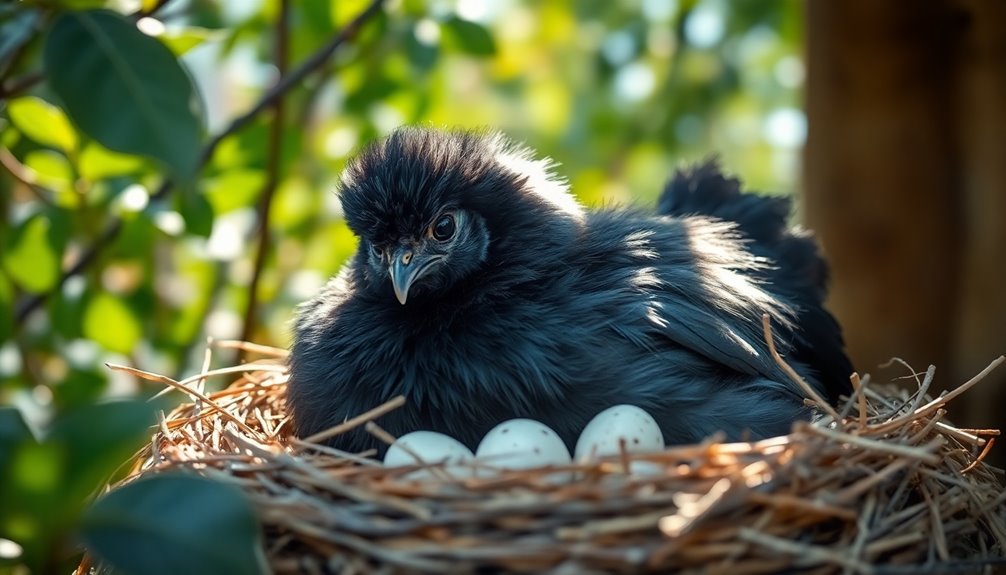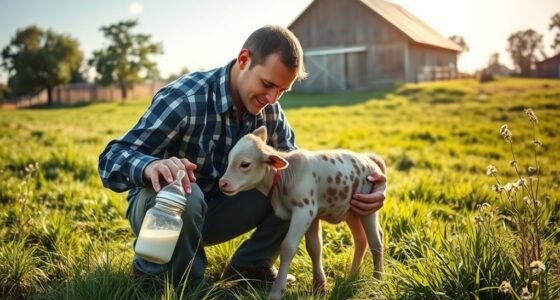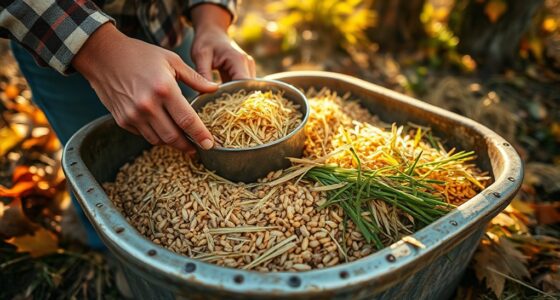To manage and encourage egg laying in your broody Silkie chickens, focus on their environment and nutrition. Ensure they have clean, spacious nesting boxes—one per 3-4 hens—plus consistent light to mimic longer days, especially in winter. Feed your Silkies balanced layer feed rich in protein, vitamins, and minerals to maintain their health. Monitor for signs of broodiness, like staying in the nest box, and intervene if necessary to prevent health issues. With proper management, you can promote egg laying while keeping your hens healthy and happy. There's so much more to explore as you enhance their care.
Key Takeaways
- Monitor and manage broodiness by removing hens from nesting boxes to encourage them to resume laying eggs.
- Provide consistent lighting schedules with supplemental light during winter to stimulate egg production.
- Ensure a clean, spacious living environment with adequate nesting boxes to promote regular laying behavior.
- Maintain a balanced diet with appropriate protein levels to support egg production and overall health.
- Regularly check for health issues or parasites that may affect egg-laying performance and wellbeing.
Egg Laying Overview
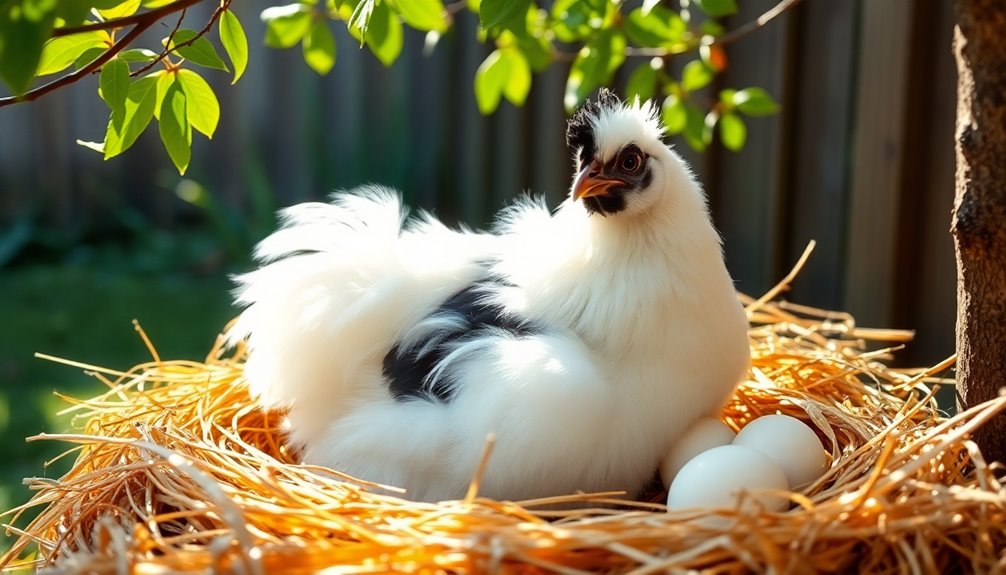
Silkie chickens typically lay eggs consistently throughout the year, making them a reliable choice for backyard poultry keepers. You can expect your Silkies to produce between 110 and 155 eggs annually, averaging about 2-3 eggs per week.
In some cases, a particularly productive Silkie might lay 4 or 5 eggs weekly, though that's less common. Their eggs are small to medium-sized, typically cream-colored or white, and richer in nutrients compared to other breeds. Silkie chickens are also known for their high tendency to go broody and care for their chicks, which can further encourage egg laying.
Silkies usually start laying around 7 to 9 months of age, with peak production occurring in their first two to three years. While age and environmental factors can influence their laying frequency, Silkies are known for their resilience, even in colder months.
Understanding Broodiness
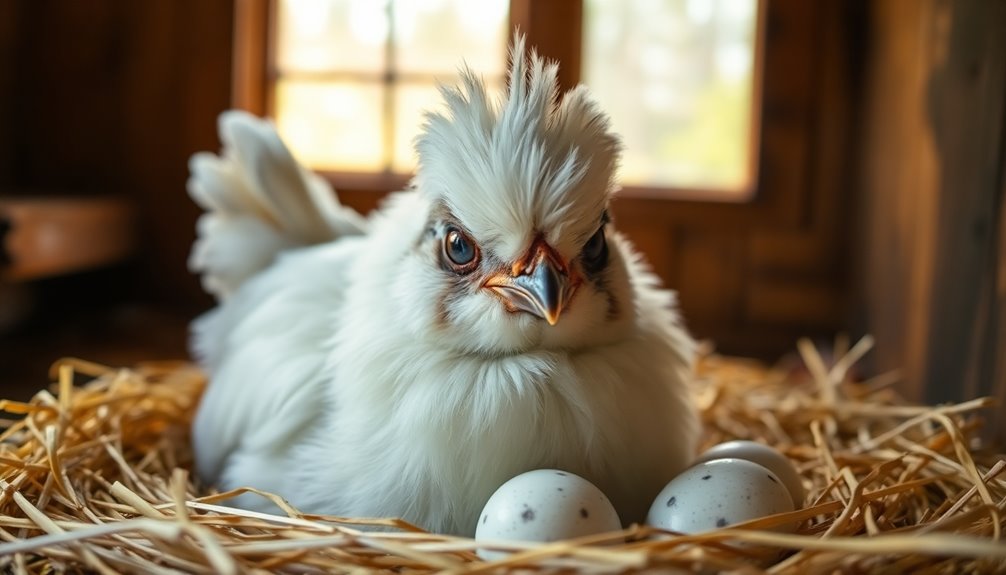
In the world of poultry, understanding broodiness is crucial for effective management of your flock.
Broodiness is an instinctual state driven by hormones, causing hens to stop laying eggs and sit on a clutch for 21 days. You might notice your Silkie or other breeds like Cochins exhibiting behaviors such as staying in the nest box continuously, puffing up their feathers, and even growling if disturbed. They'll leave the nest only briefly for food and water. However, this behavior can lead to weight loss and health issues if unchecked. Broodiness can spread among hens, causing multiple hens to share nests. Recognizing these signs helps you manage their broodiness effectively, ensuring your hens stay healthy while also maintaining egg production in your flock.
Environmental Influences

Creating a comfortable environment for your hens significantly influences their egg-laying capabilities.
Start by providing clean and spacious living areas; aim for one nesting box for every three to four hens to reduce competition and stress. Ensure these boxes are well-designed and predator-proof to create a safe space that encourages laying. Additionally, providing appropriate bedding materials can enhance comfort and encourage laying behavior.
Lighting plays a crucial role too; use supplemental light during winter to mimic longer daylight hours, which can stimulate egg production. Maintain consistent lighting schedules for regular laying.
Additionally, control the temperature within the coop, keeping it comfortable to prevent stress. Proper lighting conditions and good ventilation are essential to maintain health and productivity, while biosecurity measures help minimize any external threats.
Nutritional Needs
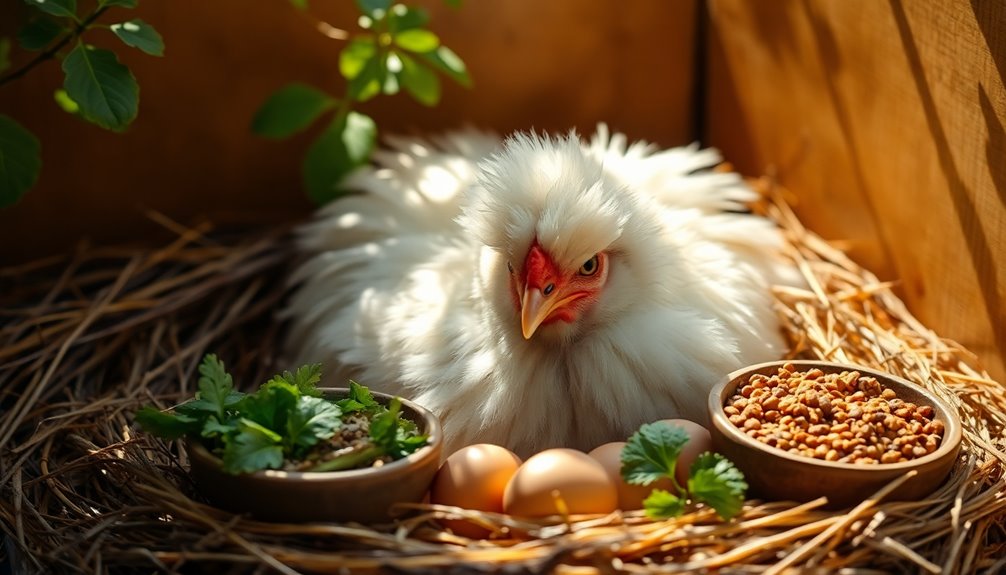
Proper nutrition is vital for keeping your Silkie chickens healthy and productive.
Start your chicks on a feed with 20-22% protein for the first few weeks to support their rapid growth. After eight weeks, transition to a grower feed with 16-18% protein.
Include carbohydrates from grains like corn, wheat, and oats for energy. Ensure your feed contains 5-8% fats for healthy skin and feathers while providing essential fatty acids. Additionally, remember to provide chick-sized grit to help with digestion, especially if they are foraging or consuming treats.
Don't forget vitamins A, D, E, K, and B-complex, along with calcium and phosphorus for bone development.
For adults, offer 2-4 ounces of balanced layer feed daily, and provide free-choice access to fresh water.
Treats like dried grubs and leafy greens can add variety, but avoid overfeeding.
Health and Safety
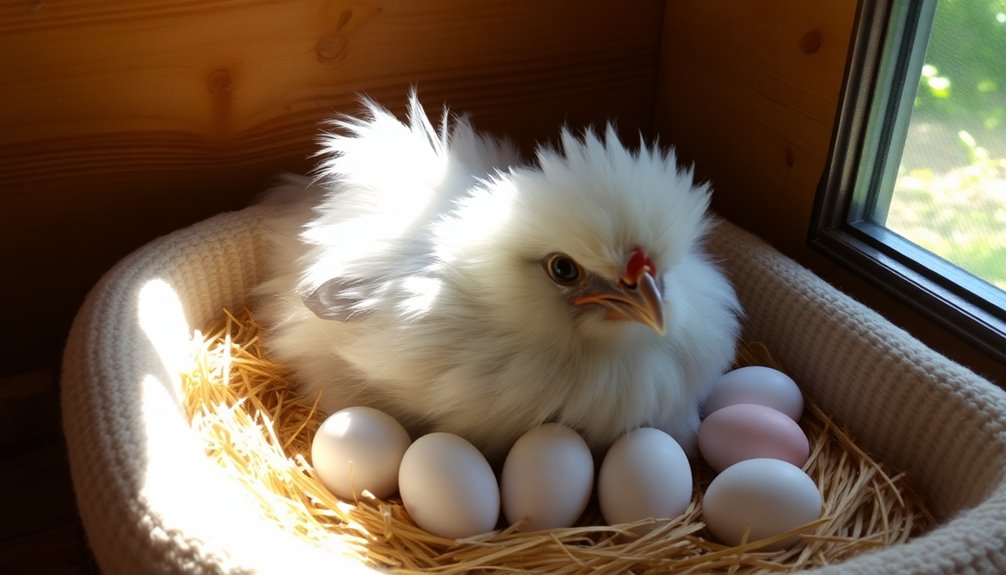
While Silkie chickens are known for their unique appearance and friendly nature, their health and safety require careful attention to several factors.
Their vaulted skulls can make them vulnerable to injury, so keep them with non-aggressive flock members. Monitor for common issues like wry neck or neurological difficulties, and consider vaccinating against Marek's disease. Regular health check-ups are essential for early detection of health issues that may arise.
Regularly check for parasites like lice and scaly leg mites, as Silkies are especially prone due to their fluffy feathers. Maintain a clean coop environment and help prevent infections by regularly cleaning their foot feathers.
Also, be cautious during wet and cold weather to protect them from getting soaked, which can lead to serious health problems. Always prioritize their health to ensure happy, thriving Silkies.
Breeding Considerations
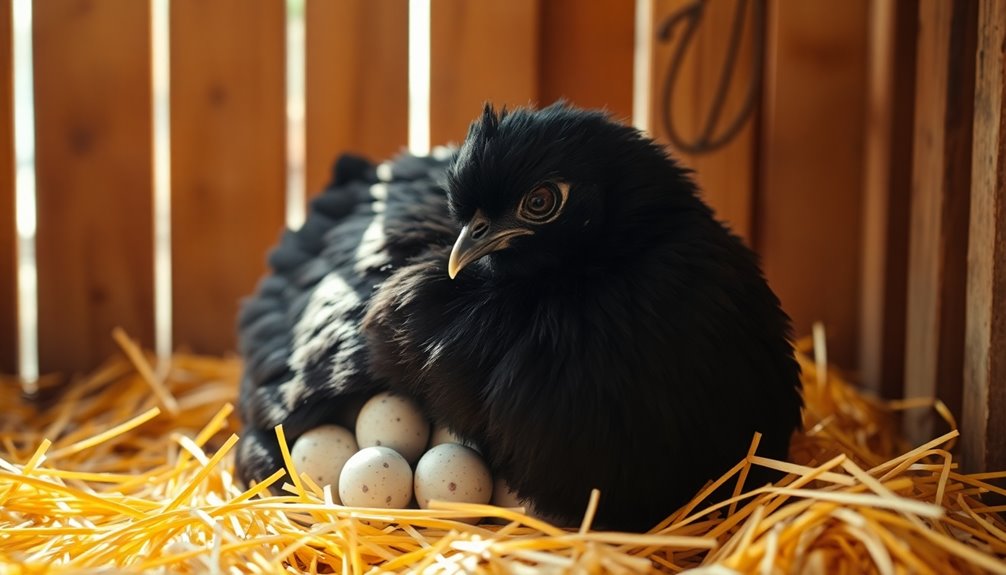
When it comes to breeding Silkie chickens, careful consideration of their physical traits and genetic diversity is essential for achieving desirable results.
Choose birds that meet the American Poultry Association breed standard, focusing on their fluffy plumage, crested heads, and broad body type. Silkie chickens are well known for their unique appearance, which makes them stand out in any flock.
It's vital to maintain genetic diversity to prevent inbreeding issues, so consider using different breeding lines and even crossbreeding with other breeds to enhance qualities like egg-laying.
Select hens known for their strong broody instincts and ensure roosters are fertile.
Keep track of lineage and monitor hatching success to refine your breeding strategies.
Lastly, prioritize hardiness and adaptability, ensuring your Silkies can thrive in varying climates and remain resilient to health issues.
Frequently Asked Questions
How Can I Tell if My Silkie Is Going Broody?
You can tell if your Silkie is going broody by observing her behavior.
She'll likely stay in her nesting box, clucking loudly if you approach. If she flattens her body and pulls out feathers, that's a clear sign.
You might notice she's reluctant to leave the nest for food and water, and she may puff up or growl if disturbed.
Keep an eye out for these changes to confirm her broodiness.
Do Silkies Require Specific Nesting Materials for Egg Laying?
Silkies don't require specific nesting materials, but using comfortable options can encourage egg laying.
You can line nesting boxes with fresh straw, wood shavings, or even shredded newspaper. Make sure the bedding is clean and dry, as this helps maintain a healthy environment.
A depth of about 2-4 inches is ideal for comfort. Regularly check and replace soiled bedding to keep your hens happy and promote consistent egg production.
Can Silkies Lay Eggs During Winter Months?
Yes, Silkies can lay eggs during winter months. Their fluffy feathers keep them warm, allowing for consistent laying even in colder weather.
You might notice they lay around 2-3 eggs per week, sometimes more. To support this, ensure they've a balanced diet with enough protein and calcium, and provide fresh water daily.
A cozy coop environment will also help maintain their egg production throughout winter.
How Does Age Affect a Silkie's Egg Production?
Age significantly impacts a Silkie's egg production. When your Silkies reach about 7-9 months, they start laying eggs, with their peak production occurring in the first two years.
During this time, you can expect 2-5 eggs per week. After their second or third year, production gradually declines, and by age five, they might produce half as many eggs.
What Signs Indicate Nutritional Deficiencies in Laying Silkies?
When you notice signs of nutritional deficiencies in your laying Silkies, pay attention to watery eye discharge, sparse feathers, or changes in behavior.
You might see reduced appetite, weight loss, or lethargy. If your hens are laying thin-shelled eggs or their egg production declines, it's a red flag.
Look for leg weakness, curled toes, or dry skin as further indicators. Ensuring a balanced diet can help prevent these issues.
Conclusion
In conclusion, managing and encouraging egg laying in your silkie chickens requires a keen understanding of their unique needs. By providing the right environment, nutrition, and health care, you can foster their egg production. Remember to consider their broodiness and breeding aspects, as these factors play a significant role in their laying habits. With a little attention and care, you'll enjoy the rewards of healthy, happy silkie chickens that lay plenty of eggs for you.

